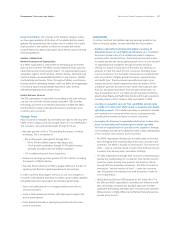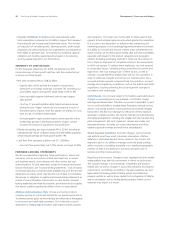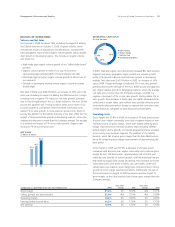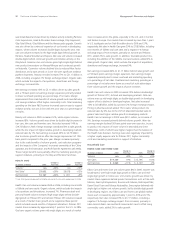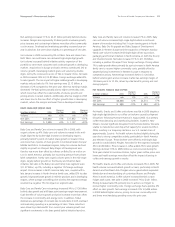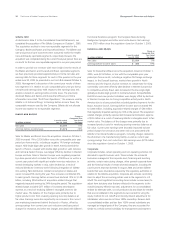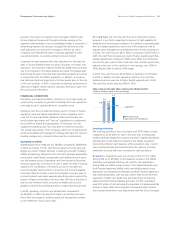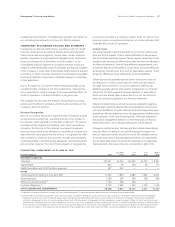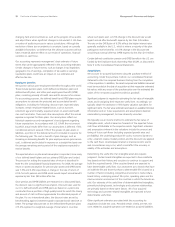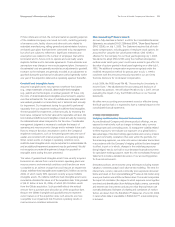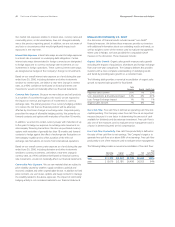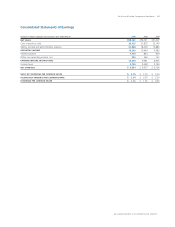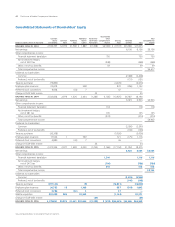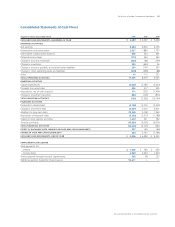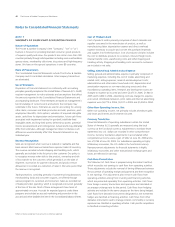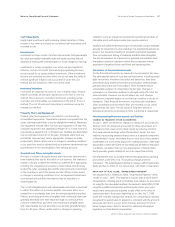Proctor and Gamble 2006 Annual Report Download - page 39
Download and view the complete annual report
Please find page 39 of the 2006 Proctor and Gamble annual report below. You can navigate through the pages in the report by either clicking on the pages listed below, or by using the keyword search tool below to find specific information within the annual report.
The Procter &Gamble Company and Subsidiaries 37Management’s Discussion and Analysis
Contractual Commitments. The table below provides information on
our contractual commitments as of June 30, 2006 (in millions).
SIGNIFICANT ACCOUNTING POLICIES AND ESTIMATES
In preparing our financial statements in accordance with U.S. GAAP,
there are certain accounting policies that are particularly important.
These include revenue recognition, income taxes, certain employee
benefits, acquisitions and goodwill and intangible assets. We believe
these accounting policies, and others set forth in Note 1 to the
Consolidated Financial Statements, should be reviewed as they are
integral to understanding the results of operations and financial condition
of the Company. In some cases, these policies simply represent required
accounting. In others, they may represent a choice between acceptable
accounting methods or may require substantial judgment or estimation
in their application.
Due to the nature of our business, these estimates generally are not
considered highly uncertain at the time of estimation, meaning they
are not expected to result in changes that would materially affect our
results of operations or financial condition in any given year.
The Company has discussed the selection of significant accounting
policies and the effect of estimates with the Audit Committee of the
Company’s Board of Directors.
Revenue Recognition
Most of our revenue transactions represent sales of inventory, and we
recognize revenue when title, ownership and risk of loss transfer to
the customer, which generally is on the date of shipment. The revenue
recorded includes shipping and handling costs, which generally are
included in the list price to the customer. A provision for payment
discounts and product return allowances is recorded as a reduction of
sales within the same period that the revenue is recognized. We offer
sales incentives to customers and consumers through various programs,
consisting primarily of customer pricing allowances, merchandising funds
and consumer coupons. The cost of these programs is recognized as
incurred and recorded as a reduction of sales. Given the nature of our
business, revenue recognition practices do not contain estimates that
materially affect results of operations.
Income Taxes
Our annual tax rate is determined based on our income, statutory tax
rates and the tax impacts of items treated differently for tax purposes
than for financial reporting purposes. Tax law requires certain items to be
included in the tax return at different times than the items are reflected in
the financial statements. Some of these differences are permanent, such
as expenses that are not deductible in our tax return, and some differences
are temporary, reversing over time, such as depreciation expense. These
temporary differences create deferred tax assets and liabilities.
Deferred tax assets generally represent items that can be used as a
tax deduction or credit in future years for which we have already
recorded the tax benefit in our income statement. Deferred tax
liabilities generally represent tax expense recognized in our financial
statements for which payment has been deferred, or expenditures
whichwehavealreadytakenadeductionforinourtaxreturnbut
have not yet been recognized in our financial statements.
Inherent in determining our annual tax rate are judgments regarding
business plans, planning opportunities and expectations about future
outcomes. Realization of certain deferred tax assets is dependent upon
generating sufficient taxable income in the appropriate jurisdiction prior
to the expiration of the carry-forward periods. Although realization is
not assured, management believes it is more likely than not that our
deferred tax assets, net of valuation allowances, will be realized.
Changes in existing tax laws, tax rates and their related interpretations
may also affect our ability to successfully manage the impacts on
taxes of regulatory matters around the world. We establish reserves
for certain tax positions that management believes are supportable,
but are potentially subject to successful challenge by the applicable
taxing authority. We review these tax uncertainties in light of the
CONTRACTUAL COMMITMENTS AS OF JUNE 30, 2006
Less Than 1 – 3 3 – 5 After 5
(in millions of dollars) Total 1 Year Years Years Years
RECORDED LIABILITIES
Total debt $37,501 $2,059 $22,699 $3,752 $ 8,991
Capital leases 632 90 278 92 172
Wella Domination and Profit Transfer Agreement 207 207 — — —
OTHER
Interest payments relating to long-term debt 11,923 1,850 2,485 1,087 6,501
Operating leases 1,399 269 394 308 428
Minimum pension funding (1) 1,136 398 738 — —
Purchase obligations (2) 5,700 1,940 1,593 1,002 1,165
TOTAL CONTRACTUAL COMMITMENTS 58,498 6,813 28,187 6,241 17,257
(1) Represents future pension payments to comply with local funding requirements. The projected payments beyond fiscal year 2009 are not currently determinable.
(2) Primarily reflects future contractual payments under various take-or-pay arrangements entered into as part of the normal course of business. Commitments made under take-or-pay obligations
represent future purchases in line with expected usage to obtain favorable pricing. Approximately 50% relates to service contracts for information technology, human resources management
and facilities management activities that were outsourced in recent years. While the amounts listed represent contractual obligations, we do not believe it is likely that the full contractual amount
would be paid if the underlying contracts were canceled prior to maturity. In such cases, we generally are able to negotiate new contracts or cancellation penalties, resulting in a reduced payment.
The amounts do not include obligations related to other contractual purchase obligations that are not take-or-pay arrangements. Such contractual purchase obligations are primarily purchase orders
at fair value that are part of normal operations and are reflected in historical operating cash flow trends. We do not believe such purchase obligations will adversely affect our liquidity position.


